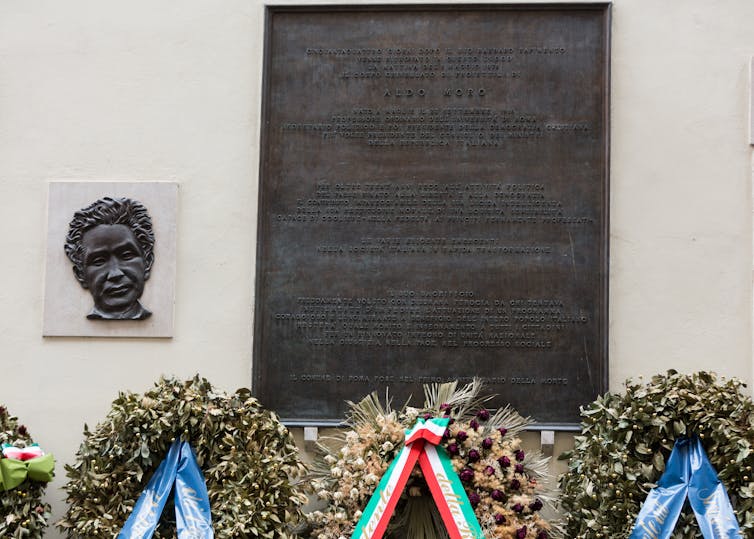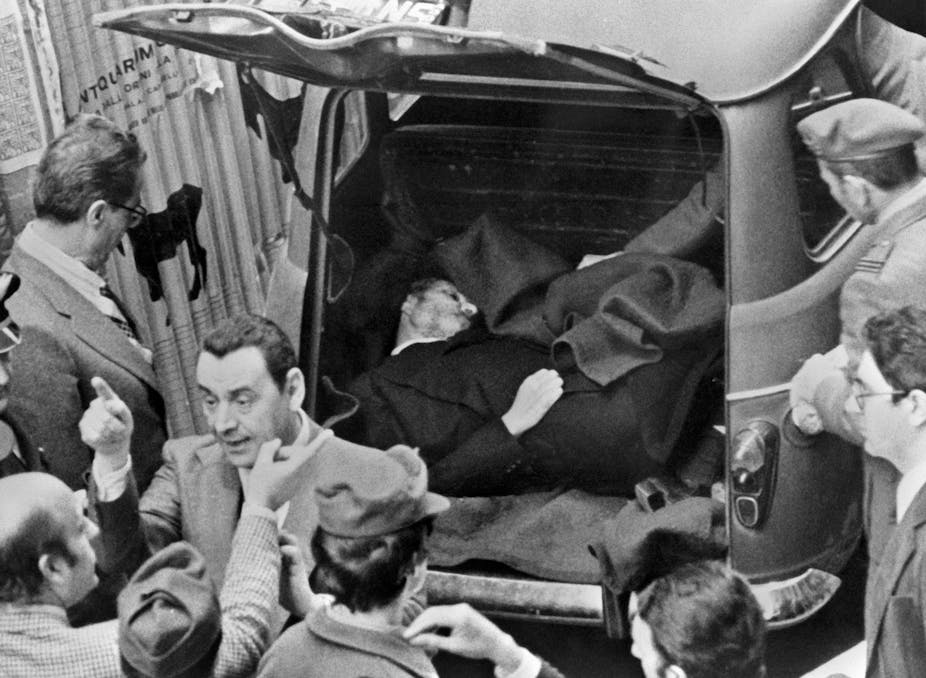Central Rome, 9 May 1978. A crowd of curious passersby spills out by an open car boot. There lies the bullet-riddled body of Aldo Moro, Italy’s Prime Minister, parked mid-way between the party headquarters of the Christian Democrats and those of the Communist Party. The scene concludes 55 days of kidnap and sequestration by the Marxist revolutionaries of the Red Brigades.
One of the darkest chapters in Italian history, the Aldo Moro affair continues to be revisited and written up to this day. Acclaimed film director Marco Bellocchio is the latest to add his take. In his mini-series Esterno Notte (“Exterior Night”), which was broadcast on French-German channel Arte throughout March, Bellochio walks us through the tortuous and often little-known history of Italian terrorism.
Bellocchio gives the floor to the tragedy’s protagonists: from the members of the Red Brigades to Aldo Moro himself, without forgetting his family and the representatives of the political class of the time. The assassination remains a national trauma closely linked to the “Years of Lead” in Italy, which spanned the late 1960s to the early 1980s.
Against the backdrop of the Cold War, the period saw a steady rise in political, economic and social tensions, ultimately culminating in a spate of terrorist attacks from the far left and right. Then the head of the Christian Democracy party, Aldo Moro sought to rally the nation around a government of “historical compromise” that would have brought in the general secretary of the Communist Party, Enrico Berlinguer. But the Red Brigades had other ideas, viewing the proposal as a sell-out from the communists.
From terrorist communiqués to official statements and letters written by Moro during his captivity, Esterno Notte exposes a tale of vengeful escalation in merciless detail. Each side intends to fight its corner at all costs, without compromise. The Red Brigades, a far-left terrorist organisation founded in the early 1970s that took up “armed propaganda” in the name of the workers’ movement, are strengthened hour by hour in their vengeful resolve, just as the Italian authorities are strengthened in their resolve to annihilate them.
The ruthless escalation of terrorist vengeance
Was there ever any chance Moro could have escaped the “people’s prison”? Could he have exited the parallel proletarian justice system in which the Red Brigades “tried” him, as Bellocchio suggests when he brings him back to life in the introduction to his work? And, had the Italian government accepted their terms, could the Red Brigades have compromised by releasing him?
The argument that the Italian government could have negotiated with the Red Brigades is often put forward in certain academic literature, media and artistic intepretations, and here reclaimed by Esterno Notte. However, this omits how tenacious the Red Brigades were in seeking revenge, and how an unfavourable historical and socio-political environment could corner all parties into the impasse of violence.
Often performative when it comes to revenge, discourse is central to this series, both in terms of the action it inspires and the events it reports. The first communiqué of the Red Brigades, which immediately follows Moro’s kidnapping on 16 March 1978, leaves no doubt as to the abductors’ bloody intentions. The talk is one of “annihilation”, posited by radical activists as the answer to a “bourgeois and imperialist counter-revolution” and to the “bloody policies” of which Moro would be the “political godfather and the most faithful executor”.

A state dragged into the mud of retribution
Another problem that Esterno Notte tackles head-on is the reaction of the authorities to this ruthless progression of revenge in the terrorist camp, even though we know a posteriori at what price this revenge will come for the Red Brigades. Why did the state apparatus refuse to negotiate with Moro’s kidnappers, when he expressly asked the government to release him and when the political elites were divided over the best course of action? The line that eventually emerged was that any mediation with the Red Brigades would be tantamount to complicity with the terrorists’ negotiation strategy and thus legitimise their violence, in a sensitive context marked by the death of many policemen since Italy launched its “war on terror”.
Writing in the Corriere della Sera, the writer and columnist Indro Montanelli argued that:
“If the Italian State had yielded to blackmail and negotiated with the violent forces that had already caused the death of five of Moro’s bodyguards, then the State, as a State, would no longer have any reason to exist.”
In other words, power had no alternative but to freeze into a stance of counter-retribution.
Consumed by their revenge, the Red Brigades systematically rejected any genuine discussion with the authorities, opting instead to send the government a succession of murderous messages. Thus, no exchange of prisoners took place, while all the political parties ended up rallying behind the certainty that no democratic state in the world could bargain with terrorism.

Terrorism’s unforgivable crimes
Last but not least, what can we learn from Esterno Notte about the eminently complex relationship between terrorism and forgiveness, especially in relation to the possibility, or not, of forgiving terrorists? Is forgiveness even conceivable as a response to terrorism, a supreme crime in the eyes of all societies? Symptomatically, when it comes to terrorist acts, forgiveness is often absent and unattainable. While Moro evokes in one of his letters the forthcoming “moment of massacre” and implores the authorities to intervene, he also appears to have already relinquished the possibility by announcing that he will not forgive anyone and that no political party or government member will be able to attend his funeral.
If the character of Aldo Moro and his letters have inspired a great deal of interpretations since, it is important to question the quasi-“Christology” that Bellochio’s Esterno Notte dubs its subject with from the beginning. It is true that the victims of terrorism can sometimes forgive. But in this case, and contrary to the imaginary resurrection of Moro and the sacrificial, if not martyrological picture developed here, which tends to suggest a form of forgiveness on the part of the former leader, let us emphasise, once again, that he never forgave anything, either to his executioners, or to the authorities after they renounced saving him. This is probably the ultimate revenge that Moro could individually achieve.
In the end, Italian society has yet to assimilate this exceptionally brutal episode. Moro’s assassination remains an indelible stain on local culture, marring not only political and media narratives, but also the very process of remembrance of terrorism. As the researcher Nicolas Demertzis points out in an evocative contribution, exorcising the shock of violence means forgiving its use in order to reconcile with the past. On the one hand, the Italian “Years of Lead” remain subject to controversy and are frequently instrumentalised by competing parties. On the other, the cycle of terrorist revenge and state counter-retribution tends to culminate, by nature, in the radical refusal of forgiveness. According to Demertzis, this ultimately amounts to “[defending][the integral subjectivity of the victim” and “[ethically protesting] against the unjustifiable evils and wrongs” inflicted by terrorism.


